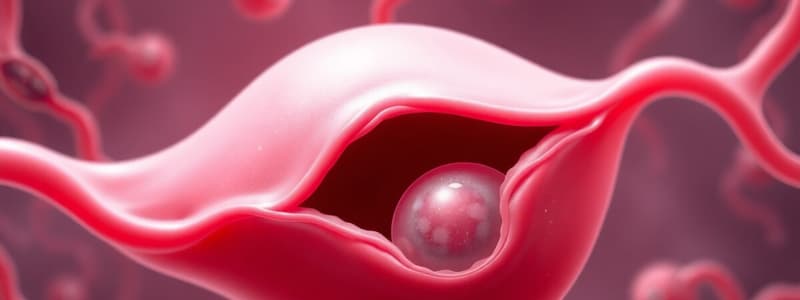Podcast
Questions and Answers
Identify two key differences in the timing and duration of oogenesis and spermatogenesis in humans.
Identify two key differences in the timing and duration of oogenesis and spermatogenesis in humans.
Oogenesis begins before birth and has long interruptions, not completing until fertilization, whereas spermatogenesis begins at puberty and is a continuous process throughout a male's life. Oogenesis releases one viable ovum, whereas spermatogenesis produces four viable sperm.
Explain the significance of the unequal cytokinesis in oogenesis compared to the equal cytokinesis in spermatogenesis. How does this difference support the function of each process?
Explain the significance of the unequal cytokinesis in oogenesis compared to the equal cytokinesis in spermatogenesis. How does this difference support the function of each process?
Unequal cytokinesis in oogenesis concentrates cytoplasm and organelles in one large ovum, providing nutrients for the developing embryo. Equal cytokinesis in spermatogenesis creates four small, motile sperm to maximize chances of fertilization.
Describe how the meiotic divisions differ between oogenesis and spermatogenesis in terms of the number of functional gametes produced and the fate of any byproducts.
Describe how the meiotic divisions differ between oogenesis and spermatogenesis in terms of the number of functional gametes produced and the fate of any byproducts.
Oogenesis results in one functional ovum and two or three polar bodies, which degenerate. Spermatogenesis results in four functional sperm cells. This difference is primarily due to the unequal cytokinesis in females.
Compare and contrast the roles of hormones, such as follicle-stimulating hormone (FSH) and luteinizing hormone (LH), in regulating oogenesis and spermatogenesis.
Compare and contrast the roles of hormones, such as follicle-stimulating hormone (FSH) and luteinizing hormone (LH), in regulating oogenesis and spermatogenesis.
A drug interferes with synaptonemal complex formation during meiosis. How would this impact oogenesis and spermatogenesis, and what specific meiotic event would be most affected?
A drug interferes with synaptonemal complex formation during meiosis. How would this impact oogenesis and spermatogenesis, and what specific meiotic event would be most affected?
Flashcards
Spermatogenesis
Spermatogenesis
The production of sperm cells in males.
Oogenesis
Oogenesis
The production of egg cells in females.
Spermatogenesis Output
Spermatogenesis Output
Spermatogenesis produces four viable sperm cells from each precursor cell.
Oogenesis Output
Oogenesis Output
Signup and view all the flashcards
Location of Spermatogenesis
Location of Spermatogenesis
Signup and view all the flashcards
Location of Oogenesis
Location of Oogenesis
Signup and view all the flashcards
Study Notes
- Oogenesis and spermatogenesis are the processes of gametogenesis in females and males, respectively
- Both processes involve meiosis, but they differ significantly in timing, quantity, and outcome
Timing
- Spermatogenesis begins at puberty and continues throughout life
- Oogenesis begins during fetal development, arrests at prophase I, resumes at puberty, and ceases at menopause
Location
- Spermatogenesis occurs in the seminiferous tubules of the testes
- Oogenesis occurs in the ovaries
Starting Cells
- Spermatogenesis starts with spermatogonia
- Oogenesis starts with oogonia
Cell Division
- Spermatogenesis involves equal cytoplasmic divisions during meiosis I and II
- Oogenesis involves unequal cytoplasmic divisions, producing one large ovum and polar bodies
Meiotic Arrest
- Spermatogenesis has no meiotic arrest
- Oogenesis arrests in prophase I until puberty and metaphase II until fertilization
Number of Gametes Produced
- Spermatogenesis produces four viable sperm cells from each primary spermatocyte
- Oogenesis produces one viable ovum and two or three polar bodies from each primary oocyte
Gamete Size and Structure
- Sperm are small, motile cells with a flagellum
- Ova are large, non-motile cells with abundant cytoplasm
Hormone Regulation
- Spermatogenesis is regulated by testosterone and follicle-stimulating hormone (FSH)
- Oogenesis is regulated by estrogen, progesterone, luteinizing hormone (LH), and FSH
Duration
- Spermatogenesis takes approximately 64-72 days to complete
- Oogenesis can take years, from fetal development to ovulation
Outcome
- Spermatogenesis results in a continuous supply of sperm
- Oogenesis results in a finite number of ova released during a woman's reproductive years
Purpose
- The purpose of spermatogenesis is to produce a large number of motile sperm to increase the chances of fertilization
- The purpose of oogenesis is to produce a single, nutrient-rich ovum ready for fertilization and development
Error Rate
- Spermatogenesis has a relatively low error rate
- Oogenesis has a higher error rate, leading to a greater risk of chromosomal abnormalities
Polar Bodies
- Spermatogenesis does not produce polar bodies
- Oogenesis produces polar bodies, which are small cells with little cytoplasm that eventually degenerate
Cytoplasmic Contribution
- Sperm contribute primarily DNA to the zygote
- Ova contribute DNA, cytoplasm, organelles, and nutrients to the zygote
Menopause
- Spermatogenesis continues throughout a male's life, although sperm quality may decline with age
- Oogenesis ceases at menopause, marking the end of a woman's reproductive capability
Studying That Suits You
Use AI to generate personalized quizzes and flashcards to suit your learning preferences.




